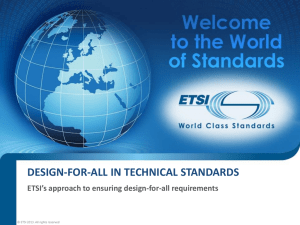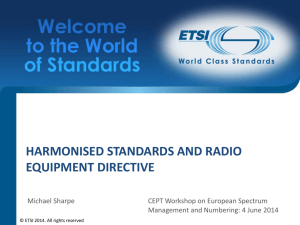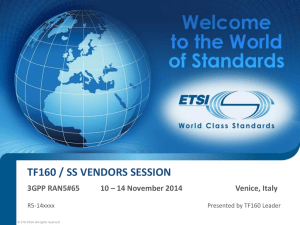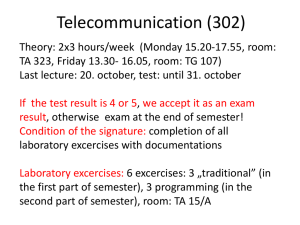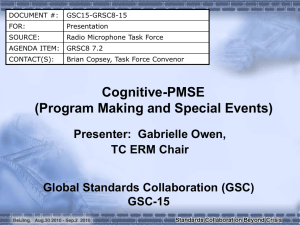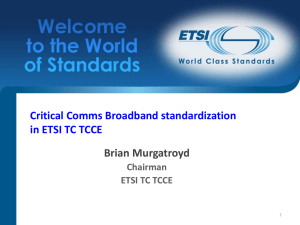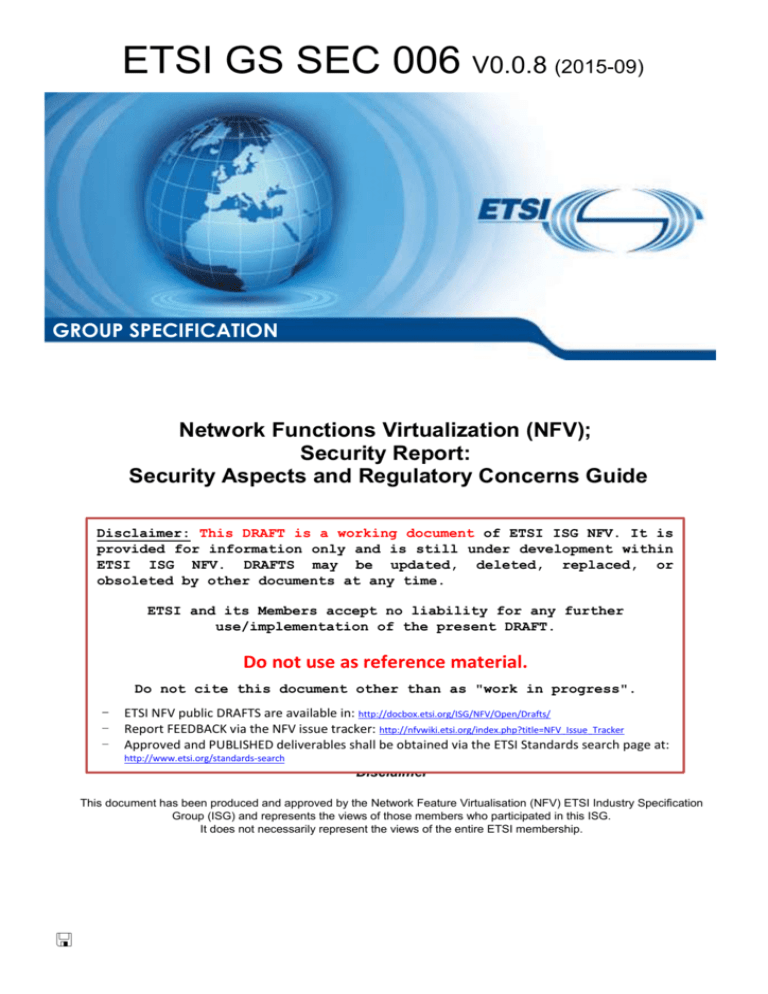
ETSI GS SEC 006 V0.0.8 (2015-09)
GROUP SPECIFICATION
Network Functions Virtualization (NFV);
Security Report:
Security Aspects and Regulatory Concerns Guide
Disclaimer: This DRAFT is a working document of ETSI ISG NFV. It is
provided for information only and is still under development within
ETSI ISG NFV. DRAFTS may be updated, deleted, replaced, or
obsoleted by other documents at any time.
ETSI and its Members accept no liability for any further
use/implementation of the present DRAFT.
Disclaimer
Do not use as reference material.
This document has been produced and approved by the Open Radio equipment Interface (ORI) ETSI Industry Specification
Do not cite this document other than as "work in progress".
Group (ISG) and represents the views of those members who participated in this ISG.
It does
not necessarily
represent
the views of the entire ETSI membership.
- ETSI NFV public
DRAFTS
are available
in: http://docbox.etsi.org/ISG/NFV/Open/Drafts/
-
Report FEEDBACK via the NFV issue tracker: http://nfvwiki.etsi.org/index.php?title=NFV_Issue_Tracker
Approved and PUBLISHED deliverables shall be obtained via the ETSI Standards search page at:
http://www.etsi.org/standards-search
Disclaimer
This document has been produced and approved by the Network Feature Virtualisation (NFV) ETSI Industry Specification
Group (ISG) and represents the views of those members who participated in this ISG.
It does not necessarily represent the views of the entire ETSI membership.
2
ETSI GS SEC 006 V0.0.8 (2015-09)
Reference
DGS/NFV-SEC006
Keywords
<keywords>
ETSI
650 Route des Lucioles
F-06921 Sophia Antipolis Cedex - FRANCE
Tel.: +33 4 92 94 42 00 Fax: +33 4 93 65 47 16
Siret N° 348 623 562 00017 - NAF 742 C
Association à but non lucratif enregistrée à la
Sous-préfecture de Grasse (06) N° 7803/88
Important notice
The present document can be downloaded from:
http://www.etsi.org
The present document may be made available in electronic versions and/or in print. The content of any electronic and/or
print versions of the present document shall not be modified without the prior written authorization of ETSI. In case of any
existing or perceived difference in contents between such versions and/or in print, the only prevailing document is the
print of the Portable Document Format (PDF) version kept on a specific network drive within ETSI Secretariat.
Users of the present document should be aware that the document may be subject to revision or change of status.
Information on the current status of this and other ETSI documents is available at
http://portal.etsi.org/tb/status/status.asp
If you find errors in the present document, please send your comment to one of the following services:
http://portal.etsi.org/chaircor/ETSI_support.asp
Copyright Notification
Reproduction is only permitted for the purpose of standardization work undertaken within ETSI.
The copyright and the foregoing restriction extend to reproduction in all media
No part may be reproduced or utilized in any form or by any means, electronic or mechanical, including photocopying
and microfilm except as authorized by written permission of ETSI.
The content of the PDF version shall not be modified without the written authorization of ETSI.
The copyright and the foregoing restriction extend to reproduction in all media.
© European Telecommunications Standards Institute 2015.
All rights reserved.
DECTTM, PLUGTESTSTM, UMTSTM and the ETSI logo are Trade Marks of ETSI registered for the benefit of its Members.
3GPPTM and LTE™ are Trade Marks of ETSI registered for the benefit of its Members and
of the 3GPP Organizational Partners.
ETSI
GSM® and the GSM logo are Trade Marks registered
and owned by the GSM Association.
3
ETSI GS SEC 006 V0.0.8 (2015-09)
Contents
Intellectual Property Rights ................................................................................................................................ 5
Foreword............................................................................................................................................................. 5
Modal verbs terminology ................................................................................................................................... 5
1
Scope ........................................................................................................................................................... 6
2
References ................................................................................................................................................... 6
2.1
2.2
3
3.1
3.2
3.3
4
Normative references ............................................................................................................................................... 6
Informative references ............................................................................................................................................. 6
Definitions, symbols and abbreviations ...................................................................................................... 8
Definitions ............................................................................................................................................................... 8
Symbols ................................................................................................................................................................... 8
Abbreviations ........................................................................................................................................................... 8
Security and Regulatory Concerns Guidelines.......................................................................................... 15
4.1 Overview and introduction ...................................................................................... Error! Bookmark not defined.
4.2 Domains of Attack .................................................................................................. Error! Bookmark not defined.
4.2.1 Social Engineering ............................................................................................... Error! Bookmark not defined.
4.2.1.1 Social Information Gathering Attacks............................................................... Error! Bookmark not defined.
4.2.1.2 Information Elicitation via Social Engineering ................................................. Error! Bookmark not defined.
4.2.1.3 Target Influence via Social Engineering ........................................................... Error! Bookmark not defined.
4.2.2 Supply Chain ........................................................................................................ Error! Bookmark not defined.
4.2.2.1 Integrity Modification During Manufacture ..................................................... Error! Bookmark not defined.
4.2.2.2 Integrity Modification During Distribution ....................................................... Error! Bookmark not defined.
4.2.2.3 Integrity Modification During Deployed Use ................................................... Error! Bookmark not defined.
4.2.2.4 Malicious Logic Inserted Into Product .............................................................. Error! Bookmark not defined.
4.2.3 Communications .................................................................................................. Error! Bookmark not defined.
4.2.3.1 Interception ....................................................................................................... Error! Bookmark not defined.
4.2.3.2 Protocol Manipulation....................................................................................... Error! Bookmark not defined.
4.2.4 Software ............................................................................................................... Error! Bookmark not defined.
4.2.4.1 Brute Force........................................................................................................ Error! Bookmark not defined.
4.2.4.2 Authentication Abuse ........................................................................................ Error! Bookmark not defined.
4.2.4.3 Authentication Bypass ...................................................................................... Error! Bookmark not defined.
4.2.4.4 Excavation......................................................................................................... Error! Bookmark not defined.
4.2.4.5 Buffer Manipulation .......................................................................................... Error! Bookmark not defined.
4.2.4.6 Flooding ............................................................................................................ Error! Bookmark not defined.
4.2.4.7 Path Traversal ................................................................................................... Error! Bookmark not defined.
4.2.4.8 Integer Attacks .................................................................................................. Error! Bookmark not defined.
4.2.4.9 Pointer Attack ................................................................................................... Error! Bookmark not defined.
4.2.4.10 Excessive Allocation ....................................................................................... Error! Bookmark not defined.
4.2.4.11 Resource Leak Exposure ................................................................................. Error! Bookmark not defined.
4.2.4.12 Parameter Injection ......................................................................................... Error! Bookmark not defined.
4.2.4.13 Content Spoofing ............................................................................................ Error! Bookmark not defined.
4.2.4.14 Identity Spoofing ............................................................................................ Error! Bookmark not defined.
4.2.4.15 Resource Location Spoofing ........................................................................... Error! Bookmark not defined.
4.2.4.16 Footprinting..................................................................................................... Error! Bookmark not defined.
4.2.4.17 Action Spoofing .............................................................................................. Error! Bookmark not defined.
4.2.4.18 Code Inclusion ................................................................................................ Error! Bookmark not defined.
4.2.4.19 Reverse Engineering ....................................................................................... Error! Bookmark not defined.
4.2.4.20 Functionality Misuse ....................................................................................... Error! Bookmark not defined.
4.2.4.21 Fingerprinting ................................................................................................. Error! Bookmark not defined.
4.2.4.22 Sustained Client Engagement ......................................................................... Error! Bookmark not defined.
4.2.4.23 Code Injection ................................................................................................. Error! Bookmark not defined.
4.2.4.24 Command Injection ......................................................................................... Error! Bookmark not defined.
4.2.5 Physical Security .................................................................................................. Error! Bookmark not defined.
4.2.5.1 Bypassing Physical Security ............................................................................. Error! Bookmark not defined.
4.2.5.2 Physical Theft ................................................................................................... Error! Bookmark not defined.
4.2.5.3 Physical Destruction of Device or Component ................................................. Error! Bookmark not defined.
ETSI
4
ETSI GS SEC 006 V0.0.8 (2015-09)
4.2.6 Hardware .............................................................................................................. Error! Bookmark not defined.
4.2.6.1 Footprinting....................................................................................................... Error! Bookmark not defined.
4.2.6.2 Hacking Hardware Devices or Components ..................................................... Error! Bookmark not defined.
4.3 Regulatory Concerns ............................................................................................... Error! Bookmark not defined.
4.3.1 Lawful Intercept ................................................................................................... Error! Bookmark not defined.
4.3.1.1 Isolation ............................................................................................................ Error! Bookmark not defined.
4.3.1.2 Privacy .............................................................................................................. Error! Bookmark not defined.
4.3.1.3 Completeness .................................................................................................... Error! Bookmark not defined.
4.3.1.4 Correlation ........................................................................................................ Error! Bookmark not defined.
4.3.1.5 Subject Transparency ........................................................................................ Error! Bookmark not defined.
4.3.1.6 Cross-Agency Transparency ............................................................................. Error! Bookmark not defined.
4.3.1.7 Confidentiality .................................................................................................. Error! Bookmark not defined.
4.3.1.8 Integrity ............................................................................................................. Error! Bookmark not defined.
4.3.1.9 Non-Repudiation ............................................................................................... Error! Bookmark not defined.
4.3.1.10 Record Retention ............................................................................................ Error! Bookmark not defined.
4.3.1.11 Encryption ....................................................................................................... Error! Bookmark not defined.
4.3.1.12 Delivery .......................................................................................................... Error! Bookmark not defined.
4.3.1.13 Notification ..................................................................................................... Error! Bookmark not defined.
4.3.1.14 Jurisdictions .................................................................................................... Error! Bookmark not defined.
4.3.1.15 Locality ........................................................................................................... Error! Bookmark not defined.
4.3.1.16 Subject Location ............................................................................................. Error! Bookmark not defined.
4.3.2 Retention of data for law enforcement support .................................................... Error! Bookmark not defined.
4.3.2.1 Compliance ....................................................................................................... Error! Bookmark not defined.
4.3.2.2 Locality ............................................................................................................. Error! Bookmark not defined.
4.3.3 Data Protection..................................................................................................... Error! Bookmark not defined.
4.3.4 Data and user Privacy .......................................................................................... Error! Bookmark not defined.
Annex A (normative): Proforma of Security and Regulatory Concerns for use in ETSI ISG NFV
GSs .................................................................................................................. 16
Annex <E> (informative): Authors & contributors .................................................................................... 22
Annex F (informative): Bibliography ........................................................................................................... 23
Annex G (informative): Change History .......................................................... Error! Bookmark not defined.
History .............................................................................................................................................................. 24
ETSI
5
ETSI GS SEC 006 V0.0.8 (2015-09)
Intellectual Property Rights
IPRs essential or potentially essential to the present document may have been declared to ETSI. The
information pertaining to these essential IPRs, if any, is publicly available for ETSI members and nonmembers, and can be found in ETSI SR 000 314: "Intellectual Property Rights (IPRs); Essential, or
potentially Essential, IPRs notified to ETSI in respect of ETSI standards", which is available from the ETSI
Secretariat. Latest updates are available on the ETSI Web server (http://ipr.etsi.org).
Pursuant to the ETSI IPR Policy, no investigation, including IPR searches, has been carried out by ETSI.
No guarantee can be given as to the existence of other IPRs not referenced in ETSI SR 000 314 (or the
updates on the ETSI Web server) which are, or may be, or may become, essential to the present
document.
Foreword
This Group Specification (GS) has been produced by ETSI Industry Specification Group Network
Functions Virtualisation (NFV).
Modal verbs terminology
In the present document "shall", "shall not", "should", "should not", "may", "may not", "need",
"need not", "will", "will not", "can" and "cannot" are to be interpreted as described in clause 3.2 of
the ETSI Drafting Rules (Verbal forms for the expression of provisions).
"must" and "must not" are NOT allowed in ETSI deliverables except when used in direct citation.
ETSI
6
1
ETSI GS SEC 006 V0.0.8 (2015-09)
Scope
The present document is a guide to developers of NFV related documents and applications in means to
address the security aspects and regulatory concerns as they impact the security of deployed networks
that conform with these documents and applications. The present document contains detailed
descriptions of security concerns, attacks, as well as an overview of regulatory concerns and how they
can be treated in system design to give the highest level of assurance that the resultant system is
secure and complies with current regulation and best practice. The present document is intended for
use by developers of NFV documents and the guidance is given in a manner that assists non-experts in
security and regulation to prepare such documents.
In addition to the guidance and explanatory text the present document contains, in Annex A, a
proforma template to be completed in all ETSI ISG NFV documents to capture the security concerns
and mitigations that apply.
2
References
References are either specific (identified by date of publication and/or edition number or version
number) or non-specific. For specific references, only the cited version applies. For non-specific
references, the latest version of the referenced document (including any amendments) applies.
Referenced documents which are not found to be publicly available in the expected location might be
found at http://docbox.etsi.org/Reference.
NOTE:
2.1
While any hyperlinks included in this clause were valid at the time of publication, ETSI
cannot guarantee their long term validity.
Normative references
The following referenced documents are necessary for the application of the present document.
[1]
NOTE:
2.2
Domains of Attack list and descriptions
Obtained from: http://www.mitre.org. Please consult this website for detailed
descriptions of each attack: http://capec.mitre.org/data/graphs/3000.html
Informative references
The following referenced documents are not necessary for the application of the present document but
they assist the user with regard to a particular subject area.
[i.1]
ETSI TS 102 165-1 "Telecommunications and Internet converged Services and
Protocols for Advanced Networking (TISPAN); Methods and protocols; Part 1:
Method and proforma for Threat, Risk, Vulnerability Analysis"
[i.2]
ETSI TR 187 011 "Telecommunications and Internet converged Services and
Protocols for Advanced Networking (TISPAN); NGN Security; Application of ISO15408-2 requirements to ETSI standards - guide, method and application with
examples"
[i.3]
ISO/IEC 15408-2: "Information technology - Security techniques - Evaluation
criteria for IT security - Part 2: Security functional requirements"
ETSI
7
ETSI GS SEC 006 V0.0.8 (2015-09)
[i.4]
ETSI EG 202 387: "Telecommunications and Internet converged Services and
Protocols for Advanced Networking (TISPAN); Security Design Guide; Method for
application of Common Criteria to ETSI deliverables"
[i.5]
Directive 95/46/EC of the European Parliament and of the Council of 24 October
1995 on the protection of individuals with regard to the processing of personal data
and on the free movement of such data, OJ L 281, 23.11.1995, p. 31.
[i.6]
ISO/IEC 15408-1: "Information technology - Security techniques - Evaluation
criteria for IT security - Part 1: Introduction and general model"
[i.7]
ITU-T X.509 “Information technology - Open systems interconnection - The
Directory: Public-key and attribute certificate frameworks”
[i.8]
ISO/IEC 27001:2005: “Information technology -- Security techniques -- Information
security management systems – Requirements”
[i.9]
Auguste Kerckhoffs, "La cryptographie militaire" Journal des sciences militaires, vol.
IX, pp. 5–83, January 1883, pp. 161–191, February 1883.
[i.10]
Shannon, Claude E. (July/October 1948). "A Mathematical Theory of
Communication". Bell System Technical Journal 27 (3): 379–423.
[i.11]
Computer Misuse Act 1990
NOTE:
[i.12]
NOTE:
From: http://www.legislation.gov.uk/ukpga/1990/18/contents
Privacy Impact Assessment Handbook (2009)
From: http://www.piawatch.eu/node/48
[i.13]
Directive 2002/58/EC of the European Parliament and of the Council of 12 July
2002 concerning the processing of personal data and the protection of privacy in the
electronic communications sector (Directive on privacy and electronic
communications), OJ L 201, 31.07.2002, p. 37
[i.14]
52003DC0265: Report from the Commission - First Report on the implementation of
the Data Protection Directive (95/46/EC), COM (2003) 265(01), 15.5.2003
[i.15]
COUNCIL DIRECTIVE 2008/114/EC of 8 December 2008 on the identification and
designation of European critical infrastructures and the assessment of the need to
improve their protection
[i.16]
ITU-T X.1520: SERIES X: DATA NETWORKS, OPEN SYSTEM COMMUNICATIONS AND
SECURITY; Cybersecurity information exchange – Vulnerability/state exchange;
Common vulnerabilities and exposures (January 2014)
ETSI
8
ETSI GS SEC 006 V0.0.8 (2015-09)
3
Definitions, symbols and abbreviations
3.1
Definitions
For the purposes of the present document, the [following] terms and definitions [given in ... and the
following] apply:
<defined term>: <definition>
3.2
Symbols
For the purposes of the present document, the [following] symbols [given in ... and the following]
apply:
<1st symbol><1st Explanation>
<2nd symbol><2nd Explanation>
<3rd symbol><3rd Explanation>
3.3
Abbreviations
For the purposes of the present document, the [following] abbreviations [given in ... and the following]
apply:
<1st ACRONYM><Explanation>
<2nd ACRONYM><Explanation>
<3rd ACRONYM><Explanation>
4
Security design guide
4.1
Overview and introduction
Security cannot be an afterthought, and must be considered throughout the
planning/development/deployment/runtime lifecycle. Unfortunately, effective security design is not
trivial and there is a constant tension between functionality and security that inherently couples the
two. A significant danger is that in progressing functionality it will become harder and harder to
provide deeply rooted security in system designs. As with design of any type there are a number of
ways to approach security in system design. The primary starting point in much of security is to
identify an attack and pair it with a means to thwart the attack, such that a tuple of {issue, mitigation}
will exist across the system.
ETSI
9
ETSI GS SEC 006 V0.0.8 (2015-09)
Figure 1: Illustration of a threat tree to identify forms of threat in systems
Whilst an understanding of threat trees (see Figure 1) is useful it is not sufficient and has to be
mapped to a wider understanding of countermeasures. For example the tuple {masquerade,
authentication} suggest that if the authentication element is implemented properly it will counter
masquerade, but the pre-requisites of authentication include identity management and credential
management. If authentication is a cryptographic process further issues arise that include the viability
of the authentication algorithms over time (and associated cryptographic strength), the means to
distribute credentials (the pairing of identity and the cryptographically significant data used to assert
it), and so forth.
In the regulatory domain the mind-map shown in Figure 2 identifies some of the relationships
between protection technology and attack types, and the relationship between privacy and regulation
is highlighted. The latter is important as regulation exists to protect the obligation or right to privacy
as identified in a number of acts and laws, however there are a number of exceptions to the right to
privacy identified by the same broad set of acts and laws that generally give rights for law enforcement
to have reasonable rights to protect the wider population sometimes with a short term risk to the
individual. Such exceptions include the need to provide for Lawful Interception, and to retain data in
the network in support of law enforcement.
ETSI
10
ETSI GS SEC 006 V0.0.8 (2015-09)
Figure 2: Mind-map illustrating complexity of privacy and privacy protection
In designing a secure system an understanding of the impact of attack has to be developed. For
example, when two functions share a host, a Denial of Service attack on one may affect the other. The
mitigation may be to not co-host high-priority functions with low-priority functions.
4.2
Risk, risk analysis, and risk management
Designing for the effective security of a system cannot be done without a reasonable understanding of
risk, there are a large number ways of modelling security in systems that look variously at the process
(Identify, Mitigate, Monitor as a continuous loop), and at the interactions of assets. The model given in
ETSI TS 102 165-1 [] and copied below makes a number of assumptions including:
Systems are compositions of a set of assets;
Assets may have inherent vulnerabilities;
A vulnerability when discovered with a viable threat becomes a weakness;
Exploitation of a weakness leads to something unwanted in the system (unwanted incident);
and,
Threat agents are used to enact threats and many threat agents may work together to exploit a
weakness.
ETSI
11
ETSI GS SEC 006 V0.0.8 (2015-09)
Figure 3: Generic security TVRA model from TS 102 165-1 []
There are a number of questions that arise from the generic model shown in Figure 3 and these
include:
What are the assets of my system?
How do I determine the vulnerabilities and when they become exploitable weaknesses?
How do I protect my system?
The present document is part of the process in the identification of assets and their vulnerabilities by
recommending a set of topics to be considered in every deliverable of ISG NFV.
Threats are potential events that can cause a system to respond in an unexpected or damaging way. It
is useful to categorize threats to determine effective and deployable mitigation strategies. The
identification and analysis of NFV relevant security threats (general and application specific) should
include the following categories:
Spoofing of identity (masquerade).
Tampering with data (manipulation).
Inappropriate information disclosure.
Denial of service.
Improper elevation of privileges.
The following subclauses describe a number of strategies for identifying the threats in general terms in
the NFV context.
4.3
Design for assurance
The Design for Assurance paradigm is closely aligned to the design for test paradigm. The aim of these
paradigms is to ensure that when designing a system an independent tester can validate that the
system actually performs to the design specification. The primary difference between design for test
and design for assurance is that in the latter there are specific security claims that are being made and
verified.
ETSI
12
ETSI GS SEC 006 V0.0.8 (2015-09)
Figure 4: ETSI’s Design for Assurance document suite
The core aspects of Design for Assurance are as follows: to identify the assets of the system and
through a risk analysis (identified by method in TS 102 165-1 [] in Figure 4 above); Identify the
security architecture and functionality to eliminate critical risks and to substantially reduce the
number of major risks; Reassess the risk with the assets required for risk reduction and management;
repeat. In this approach Design for Assurance is thus not very far removed from any other good design
practice – the core difference is that in defining a security measure there is a clear path to its
justification and thus a rationale for its presence which is interpreted as a claim for the security
assurance it delivers. Thus if the concern is interception across a broadcast medium (e.g. a radio link)
the attack model will be expected to show the likelihood of an attacker making the interception and
the impact of that attack, then in applying (say) encryption to the link it will show how the likelihood
of interception or the impact of an interception modifies the risk to the user and the system. The
model will also show how the countermeasure (i.e. encryption in this case) modifies the system and
what, if any, new risks are introduced. This then gives a measure of the cost benefit of the provision of
ETSI
13
ETSI GS SEC 006 V0.0.8 (2015-09)
encryption technology and the level of increased protection in such a way that it can be, if necessary,
independently validated.
There are a number of major players in the design for assurance domain and ETSI, as shown in Figure
4, has developed its guidance from the Common Criteria (ISO/IEC 15408 []) and incorporated many of
the key points into the “Making Better Standards” guidance published by ETSI CTI with support from
ETSI TC MTS. Since the original publication of this guidance the Common Criteria experts groups have
recommended a change in approach that is more closely aligned to the approach taken by ETSI with
the adoption of a principle of Community Protection Profiles (cPPs) to be developed by industry
experts in a similar way to standards. The existing cPPs (published in February 2015) covering the
following core technologies: Full Disk Encryption (FDE) Encryption Engine (EE), FDE Authorization
Acquisition (AA), Network Device, and Firewall. It is almost certain that all of these technologies will
be deployed in an NFV environment thus it would be prudent, at least, to ensure that ISG NFV
acknowledges their existence and works with the Common Criteria organisations to ensure that our
standards work in the iTC and cPP space to allow vendors, and ultimately integrators, to use these
technologies effectively.
4.4
Secure by default
The secure by default initiative documented in ETSI TR 103 309 [] is a philosophy in which real
business problems are identified and security solutions to the problems are solved at root cause,
rather than by applying patches or 'stop-gap' measures to address particular issues. The emphasis is
therefore on security mechanisms embedded in core device functions; supplied literally 'by default' in
products instead of being added afterwards via updates or complex configuration. It is considered that
an understanding of the Domain of Attack model described in clause 4.5, the appreciation of risk
described in clause 4.2, and the concept of security assurance described in clause 4.3, when taken
together and applied before a system is deployed are major components and strategies that support
the Secure by default idea.
New features of this nature require fundamental changes to devices, hence development can take time.
Promoting adoption may require that technical solutions be identified when they are still maturing;
prototypes exist to verify the concept, however market support is required in order to justify
investment in refining a product.
Finally, it is clear that simply developing technical components is almost never sufficient to solve
problems in the real world. Practical guidance is needed to ensure these components can be integrated
appropriately into deployed systems. As well as identifying technologies, it is necessary to point out
relevant good practice guidance where it exists. This has to include the Human element as very often a
technically sound and secure system is made irrelevant if a door is left open by a disgruntled or
forgetful employee.
4.5
Domain of Attack model
The domain of attack model [1] is simple in theory and divides attack vectors into sets:
Social Engineering
-
The manipulation and exploitation of people to attack the system or to gather information
about the system and its operation in order to perform future attacks. In most cases the
adversary never comes face-to-face with the victim
Supply Chain
-
Everything and anything brought into the system is part of the supply chain. The supply
chain has to be trusted sufficiently that when an asset is introduced to the system it can
ETSI
14
ETSI GS SEC 006 V0.0.8 (2015-09)
be trusted to work. This requires understanding of not just software and hardware
products, but wider issues of distribution, support, tools and so forth. Failures in the
supply chain, or attacks introduced through the supply chain, have to be considered in the
general security model and means to give supply chain assurance and validation defined.
Communications
-
Software
-
Software is the backbone of the ISG NFV and software is one of the assets of the system
that tends to exhibit a number of core vulnerabilities that when exploited lead to a
number of forms of unwanted incident. The set of checks against software design to
mitigate potential vulnerabilities are extensive and form the core of the checklist of the
present document. Attack vectors will also often be software based and may attack on
multiple paths including through operating systems, programming languages and their
associated compile and link facilities.
Physical Security
-
The model of establishment of communication between 2 parties has to meet certain
goals of confidentiality, availability and authenticity. Attacks against communication may
attack the confidentiality by intercepting the communication, or attack the availability by
disturbing the protocol in some way.
Often refers to the premises and to access control for the installed NFV hardware.
Hardware
-
Breaking the hardware will break the NFV and anything built on it.
As the ISG NFV initiative involves hardware, software and communications this checklist of attack
vectors is a useful tool to verify that all reasonable steps have been taken in managing the security and
privacy risks.
4.6
Regulatory and conformance issues
Security measures often have to be implemented to give assurance of conformance to regulation. In
security there are a number of regulations and restrictions that have to be borne in mind and these
include (the list is indicative as national legislation may extend the items that an NFV user/deployer
may have to show conformance to):
Lawful Interception
Data protection
Privacy protection
Retention of data
Export controls of dual use technologies (i.e. cryptographic material including algorithms)
Of these issues a number of concerns arise that require particular care in defining the security
solution. For LI there is a clear need for unobservability of the LI measure by unauthorised parties and
this requires a multi-tier security system. For data protection and privacy protection the current
legislation identifies roles of data controller and data processor in the system with explicit
responsibilities to manage the processing of private data (and by inference Personal Identifying
Information) with rules for accountability and for non-repudiation implicit in the requirements.
ETSI
15
ETSI GS SEC 006 V0.0.8 (2015-09)
Much of the regulatory domain and the necessary compliance is non-technical in nature although in
some cases conformance to cited standards is required. This is especially true for radio devices (as
part of the Radio Equipment Directive) and for certain electrical equipment (the CE marking) and for
medical device (including software) marking.
ETSI
16
ETSI GS SEC 006 V0.0.8 (2015-09)
Annex A (normative):
Proforma of Security and Regulatory Concerns for use in
ETSI ISG NFV GSs
A.1
Risk analysis and assessment
<<This section to essentially mimic the proforma from TS 102 165-1 with any essential updates –
could be replaced by a reference to TS 102 165-1 though.>>
Notwithstanding the provisions of the copyright clause related to the text of the present document,
ETSI grants that users of the present document may freely reproduce the TVRA definition proforma in
this annex so that it can be used for its intended purposes and may further publish the completed
TVRA definition.
ETSI
17
ETSI GS SEC 006 V0.0.8 (2015-09)
A Security Environment
a.1
Assumptions
Text of assumption
a.1.1
a.1.2
Citation for full text
a.2
Assets
Short text describing asset
a.2.1
a.2.2
Citation for full text
a.3
Threat agents
Short text describing threat agent
a.3.1
a.3.2
Citation for full text
a.4
Threats
Short text describing threat
a.4.1
a.4.2
Citation for full text
a.5
Security policies (OPTIONAL)
Short text describing security policy
a.5.1
a.5.2
Citation for full text
B Security Objectives
b.1
Security objectives for the asset
Short text describing objective for the asset
b.1.1
b.1.2
Citation for full text
b.2
Security objectives for the environment
Short text describing objective for the requirement
b.2.1
b.2.2
Citation for full text
C IT Security Requirements
c.1
asset security requirements
c.1.1 asset security functional requirements
Short text describing security functional requirement
ISO15408 class
c.1.1.1
c.1.1.2
Citation for full text
c.1.2 asset security assurance requirements
Short text describing security assurance requirement
c.1.2.1
c.1.2.2
ISO15408 class
Citation for full text
c.2
Environment security requirements (OPTIONAL)
Short text describing security environment requirement
c.2.1
c.2.2
ISO15408 class
Citation for full text
D Application notes (OPTIONAL)
E Rationale
The TVRA should define the full rational, if this is true only a citation (reference) to the full text is required
ETSI
18
A.2
Countermeasure deployment
A.2.1
Identity management
ETSI GS SEC 006 V0.0.8 (2015-09)
Successful identification is a pre-requisite for a number of security functions including authorisation
(verifying the right to do something) and authentication (verifying a claim of identity). In order to …
NOTE:
Identity management is also considered in many domains as a precursor to protection of
privacy and thus may be required for regulatory compliance under data protection and
privacy regulation.
A.2.2
Integrity protection and verification
A.2.3
Confidentiality
A.2.4
Availability and resilience
A.3
Regulatory conformance
NOTE:
A.3.1
This sub-annex identifies measures taken to assure that the NFV implementation
conforms to applicable regulation.
Data protection and Privacy
Identification of authority
Data controller
Data processor
Mechanisms implemented
Data controller
Data processor
ETSI
19
A.3.2
Retention of Data
A.3.3
Lawful Interception
Identification of point of interception
Identification of handover capability
A.3.4
Others
<Text>.
ETSI
ETSI GS SEC 006 V0.0.8 (2015-09)
20
ETSI GS SEC 006 V0.0.8 (2015-09)
Annex B (informative):
Summary of attack vectors as applied in NFV
B.1
Interception attacks
In summary an interception attack occurs when two parties, Alice and Bob, exchange data over an
open channel that is visible to the adversary Eve. If the data being exchanged by Alice and Bob is
confidential (i.e. only intended to be seen by Alice and Bob) then any interception by Eve is an attack.
There is also a set of conditions where whilst Alice represents an individual Bob may represent a
group of users and there may be many channels between Alice and each instance of Bob but Eve is
similarly multi-dimensioned.
Mitigation of interception is classically treated by encryption in order that if a channel or path is
intercepted that any material gained cannot be used by an attacker to exploit the transmission content.
In other words even if interception is possible the attacker cannot gain any advantage from the attack
as the content will be indecipherable.
B.2
Manipulation attacks
A manipulation attack is designed to alter the function of the system. Many different vectors result in
manipulation and include such things as buffer overflow, type-casting (forcing interpretation of (say) a
structured element as an integer (say)), overloading of resources (denial of service attacks fall into this
group).
Mitigation of manipulation is classically treated by the use of checksums or message hashes.
The requirements to be met of an integrity check function for detection of manipulation of something
considered immutable can be summarised by the following requirements of a cryptographic hash
function to generate a fixed length output from an arbitrary length:
One way function requirement
-
Collision resistance requirement
-
Given an input m1 it should be difficult to find another input m2 such that m1 ≠ m2 and
hash(m1) = hash(m2)
Strict Avalanche Criterion
-
Given a hash h it should be difficult to find any message m such that h = hash(m).
if 1 bit in message m changes all other bits should change with 50% probability
Bit Independence Criterion
-
output bits j and k should change independently when any single input bit i is inverted, for
all i, j and k
The challenge in general is to identify the immutable element of code or data over which the checksum
is to be calculated and where reversal of the immutability will lead to error. When this element is
correctly identified the form of function to be applied to detect manipulation has to be considered.
ETSI
21
B.3
Identity based attacks
ETSI
ETSI GS SEC 006 V0.0.8 (2015-09)
22
Annex E (informative):
Authors & contributors
The following people have contributed to this specification:
Rapporteur:
Mr Scott Cadzow, Cadzow Communications Consulting Ltd.
Other contributors:
ETSI
ETSI GS SEC 006 V0.0.8 (2015-09)
23
Annex F (informative):
Bibliography
ETSI
ETSI GS SEC 006 V0.0.8 (2015-09)
24
ETSI GS SEC 006 V0.0.8 (2015-09)
History
Document history
0.01
November
2014
First draft
0.0.2
February 2015 Updated with initial text on model and revision of scope. Input to NFVSEC#45 at NFV#9 in Prague
0.0.3
February 2015 Output of NFV-SEC#45 at NFV#9 in Prague
0.0.4
May 2015
Input to NFV-SEC#50 at NFV#10 in Sanya (China)
0.0.5
July 2015
Input to NFV-SC#54 at NFV#11 in San Jose (California)
0.0.6
July 2015
Revised and updated input to NFV-SEC#54 at NFV#11 in San Jose
(California)
0.0.7
July 2015
Output from NFV-SEC#54 at NFV#11
0.0.8
September
2015
Input to Jersey City meeting at NFV#12
ETSI



